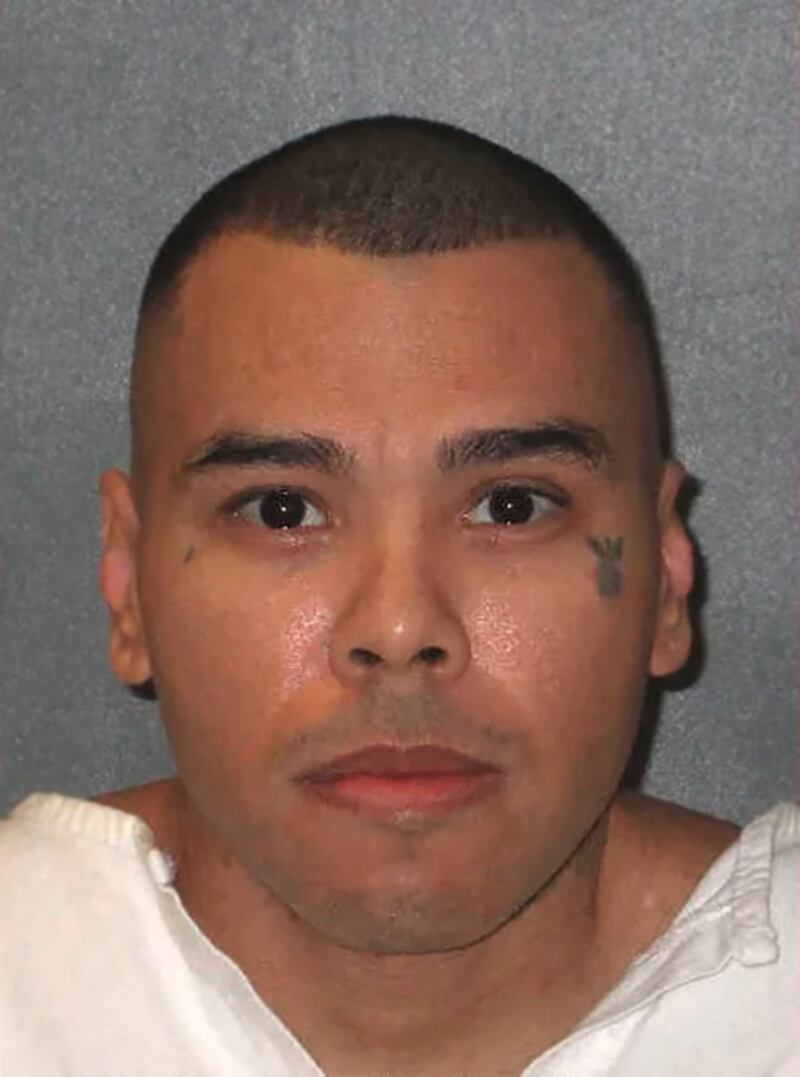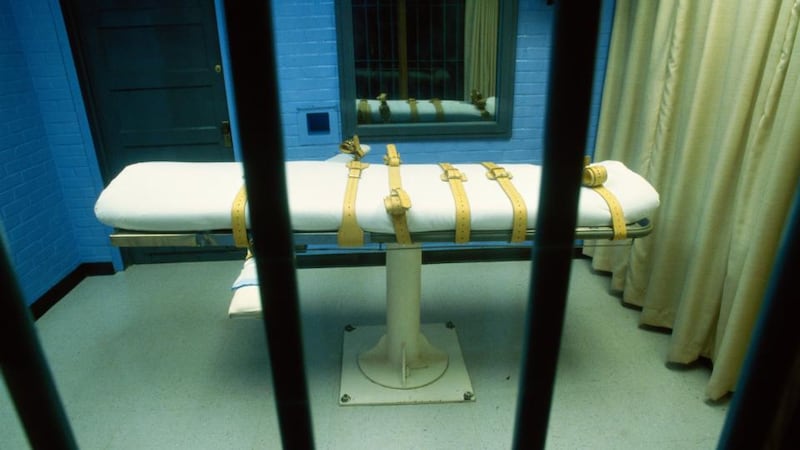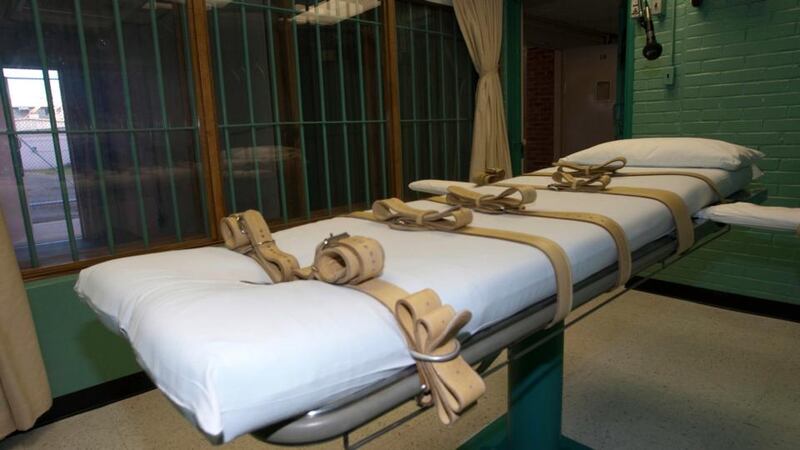It is a few minutes before six o’clock on Wednesday on an evening of stultifying heat and, outside the Huntsville “Walls Unit”, the technology won’t work. Ramiro Gonzales, from Bandera County, is to be executed at 6pm and a small, vocal band of protesters want to play the song he requested in the hope it carries through the thick red brick walls to where he is saying goodbye. But they can’t get the speaker hooked up to the phone. The atmosphere is subdued but there’s a darkly comical moment when one lady, speaking through the loudspeaker, is baffled by the song choice. “Alice In Chains! Is that a person or a band?”
On Avenue I, the evening traffic slides past. The petrol station down the hill is busy. For the past hour, the protesters have given a series of speeches, mainly to the security guards, who have heard such before. Among the speakers is Pam Parillo, who spent 40 years in prison and 20 of those on death row: in 2019, her case was overturned two days before her scheduled execution. She’s wearing the abolitionists yellow T-shirt, skinny jeans and flip-flops with an American flag design.
“If people would just open their eyes: we are killing people who kill people to show people that killing people is wrong. What sense does that make?” she asks.
“It makes no sense, people. My best friend was Karla Faye Tucker. I had to watch them drive down the street with her in the van on the way to being killed. I watched that girl for 14½ years change her life.”
READ MORE
Shortly after five, it was confirmed that the four pleas lodged with the United States Supreme Court on behalf of Gonzales had been rejected. His last chance exhausted, he would die on this day. After that, prison procedure kicked in. Two minutes before six, his legal team and family members were escorted into the prison to witness his death. The family of Bridget Townsend, for whose rape and murder in 2001 Gonzales was sentenced to death, would bear witness, too.
Earlier, I had called to the home of Michelle Lyons, who used to work with the Texas Department of Corrections as a spokeswoman on days like this. She lives with her husband just outside Huntsville: her husband is from Newcastle, England. Lyons is a Texan but with an important distinction: she is “BOI”: from Galveston and born on island.
“It’s funny. People from Texas seem to have more pride in being from this state than over most other states in the United States. Maybe Californians are similar, but you see it in all the slogans – Don’t mess with Texas; It’s a Whole Other Country. That said, in recent years I don’t share that sentiment because I am not happy with our state government.”
When she began working as a journalist, she had no idea she would end up covering the prison beat, let alone executions. But a role came up in Huntsville and her first year reporting on prisons coincided with a jaw-dropping rise in the number of state executions. The most high-profile of those was the execution of Gary Gilmore, whose case became a celebrity cause, with the Rev Jesse Jackson and Bianca Jackson leading the calls for clemency, attracting a response from white supremacists who gathered outside the prison.
“The KKK showed up with the costume regalia. I had never seen them in Texas in my life. But it got really tense outside – and it was in June. You see how hot it is. Not a great scene.”

Lyons started a job in the communications office of the Huntsville unit in 2002. Part of her role required her to witness executions and describe the last moments of inmates. It meant getting to know the death row inmates. It was a sombre and in many ways profound aspect of her job. She and her family live in a lovely, secluded development but she knows that years of exposure to the more violent reaches of Texan society have shaped her worldview.
“I hear from my child how security conscious and overly protective I am. And yeah, being over-protective of family and friends and how I look at things and see the world and people – a distrust – has been the biggest impact. You know, I always had this what I thought was an irrational fear of coming home and finding someone hiding in your closet. And one of the first executions I witnessed was of a man who had done just that. So, I think I had a little bit of it there and that took it up a hundred notches.”
Between both roles, she witnessed close to 300 executions before deciding she couldn’t continue. Towards the end, the few steps from the car to the entrance of the prison felt physically weighted. And she found that her insistence on keeping a steadfastly neutral perspective was becoming harder to maintain. She stepped away.
“After every execution we would give the victim’s family an opportunity to have a press conference. Many did. And I only remember one time where the victim’s family was upset because they did not want the execution to go through. And it of course begs the question: what is it for? It is for revenge. I don’t know ... is it wrong? I don’t know that either. Looking at this case, I am not in any way saying whether or not that man [Gonzales] has truly had a transformation. I hope he has, and I think that that is amazing if he has. If I were her parents, I don’t think I could find that level of forgiveness. And that’s where it is so complicated and what started to be my own undoing. Being in that room and seeing the victim’s families going through that. But at the same time being able to hear, over here, the inmate’s family, watching their child die. And that is where it started pulling me apart. Because everybody is losing.”
The film-maker Richard Linklater grew up in Huntsville and recently returned to make a documentary, in which Lyons participated, as part of a series titled God Save Texas on the psychic impact of living in a town famous for the deaths of prisoners. Huntsville is home to Sam Heuston state college, and it is easy for the thousands of students to enjoy life there in blissful ignorance of the scheduled deaths. It’s not as though there is a siren or a blinking of the street lights. It all takes place with quiet efficiency and at a remove. And yet the prison system is a major employer in the town. And among the artefacts in the state prison museum is the pearl-handled gun held by Bonnie Parker when she was riddled with bullets along with Clyde Barrow, and Texas’s “Ol’ Sparky”, the electric chair used for 361 executions from 1924 to 1964. Tourists can buy T-shirts with the slogan Ride the Thunderbolt, prison slang for electrocution on the infamous wooden chair. There’s a display devoted to anti-death penalty protests, including the outcry against the execution of Tucker, whose case prompted appeals from Pope John Paul II and a brother of one of her two victims. The then Texas governor George W Bush declined to block her execution, which took place in February 1998. She was the first Texan woman to be executed since 1863.
Tucker experienced a biblical and religious epiphany while in prison, similar to that undertaken by Gonzales. His clemency video revolves around the integrity and depth of his personal and spiritual transformation in prison and the staggering bleakness of his upbringing, which is an extraordinarily grim tale involving serial sexual abuse and incest and a complete surrendering to hard-core drug abuse in his teenage years. In 2003, he had been charged with a sexual assault when he told police that he was also responsible for the murder, in 2001, of Bridget Townsend, who was 18 years old. He kidnapped, raped and then shot his victim before leaving her body at an isolated spot near his grandfather’s ranch near the town of Bandera.

On Monday, the Texas Board of Pardons refused to recommend clemency for Gonzales, meaning that even had he chosen to, Texas governor Greg Abbott could not do so either. His legal counsel, Thea Posel and Raoul Schonemann, issued a statement stressing their disappointment and saying his transformation was “evident to prison officials, faith leaders, friends, family and many people across the country and world who have seen and been touched by his story”.
The statement concluded: “If Ramiro is executed on Wednesday, the world will be a darker place without him.” Within hours, they had issued an application for a stay of execution to the US Supreme Court.
By Wednesday, Patricia Townsend, Bridget’s mother, had made the five-hour journey from her home to see her daughter’s killer die by lethal injection. “He doesn’t deserve mercy,” she said in an interview on Tuesday. “And his childhood should not have anything to do with it. I know a lot of people that had a hard childhood ... he made his choice. He could be going to school or have a wife and kids. I don’t feel sorry for him, and I don’t want other people to feel sorry for him.”
Gonzales repeatedly expressed his sorrow specifically to Patricia Townsend. But he did not expect her to accept it. In December 2022, Dr Rachel Bedard, a physician who worked at Rikers Island, a New York City jail, and is an activist, wrote an opinion piece in the New York Times on the first stay of execution for Gonzales, whom she had interviewed and came to care about: she was one of many professionals struck by his spiritual renewal. It was a long, powerful piece. But the hostility towards Gonzales remained undimmed among many remarks in the comments section. “Who arbitrates life and death in a society where nobody gets it right?” Bedard reports Gonzales asking her in one of their conversations.

In his case, the answer is the Texas justice system. A 2021 University of Texas poll showed that some 63 per cent are in favour of the death penalty – a decrease from 78 per cent from the first poll, taken in 2010. On the local news channels this week, coverage was dominated by the horrific abduction, assault and murder of a 12-year-old girl, Jocelyn Nungaray, in Houston. Two undocumented immigrants have been charged and already, there is talk of the district attorney pushing for the death penalty. The number of those being sentenced to death has fallen in Texas since the advent of the “life without parole” option in 2005 but capital punishment remains an integral part of their justice system. Gonzales was one of four men listed for execution in 2024. The first of those, Ivan Cantu, was killed despite considerable doubts over his guilt after recanted testimony.
“I don’t know with the victims’ families that that is what their concern is anyway. It is not a deterrent, it is a punishment,” says Lyons on whether executions act as a deterrent.
“Righting a wrong. And some of the crimes are that terrible. I was trying hard to stay down the middle and unbiased but as time goes on it becomes more difficult to do that. It is not that I am not adamantly pro or against the death penalty. For me, it is a very complicated subject.”
[ How some Irish people escaped the death penaltyOpens in new window ]
About a mile away from the Huntsville Walls Unit and bordering the grounds of the university is Captain Joe Byrd cemetery, established in the 1850s as the burial place for prisoners who died in confinement or from execution and whose bodies were never claimed by family. It is known locally as Peckerwood Hill. More than 3,000 people lie buried there. Very few of those, as it happened, were executed. Of the 1,341 executions of prisoners in Texas since 1819, 588 have taken place since 1982, all in Huntsville. Twenty-seven states still carry the death penalty but Texas accounts for almost a third of all executions since capital punishment resumed there in 1982.

The Texas Department of Criminal Justice issue a brief “death watch” summary of Gonzales’s last few days. It is a glimpse at the monotony of prison life: 5.30pm standing at door; 6.15am sitting on bed, with tablet; 7.30am talking with staff.
But then this one entry: 11.30pm packing property.
A small lectern has been placed in the livingroom of a handsome house adjacent to the prison used for such occasions. The prison spokesperson confirmed that Gonzales’s family and friends had been present for his death. In his final statement, he apologised to Bridget Townsend’s family, singling out her mother Patricia and brother David by name. “I never stopped praying that you would forgive me and that one day I would have this opportunity to apologise.” He thanked the prison warden. He told those present: “Continue to fight the fight especially in your faith.”
With his family gathered beside him, David Townsend is emotional but speaks clearly as he explains they had finally witnessed justice being served with the execution. “Bridget was more than just a victim: she was a beloved daughter, sister and a friend with dreams and aspirations that were totally cut short at the age of 18.” He said contrary to claims in a recent article, nobody in the family was joyous. “We are not joyous; we are very sad. It’s a very sad day for everyone all the way round.” Outside, a few minutes later, Posel, Gonzales’s attorney, stands in the evening heat and gives a statement in which she acknowledges that Gonzales had, through his crimes, “caused irrevocable harm”.
“We grieve for these women and their families,” she says.
“So did he. But the Ramiro who the state of Texas killed tonight was not the Ramiro who committed those crimes 20 years ago. The Ramiro who left this world was, by all accounts, a deeply spiritual, generous and intentional person, full of remorse: someone whose driving force was love.”
The prison records will record that Gonzales was put to death on June 26th. In one of those inexplicable cosmic coincidences, this was also the date of Bridget Townsend’s birthday. She would have been 41.
- Sign up for push alerts and have the best news, analysis and comment delivered directly to your phone
- Join The Irish Times on WhatsApp and stay up to date
- Listen to our Inside Politics podcast for the best political chat and analysis





















